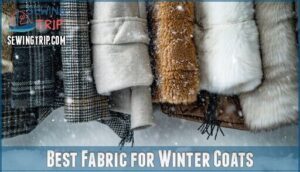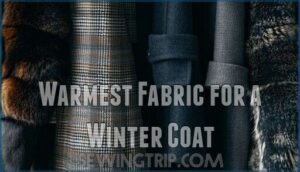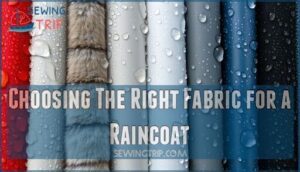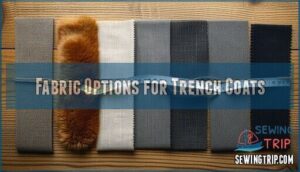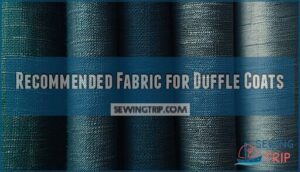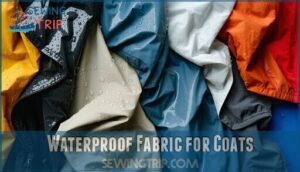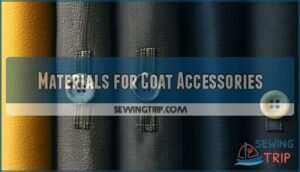This site is supported by our readers. We may earn a commission, at no cost to you, if you purchase through links.
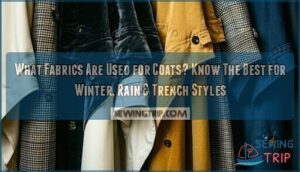 When it comes to completing a fashion look, the coat is essential and should never be overlooked. From choosing the right material for warmth in winter to finding waterproof fabric for raincoats, there are many factors that go into selecting fabrics appropriate for coats.
When it comes to completing a fashion look, the coat is essential and should never be overlooked. From choosing the right material for warmth in winter to finding waterproof fabric for raincoats, there are many factors that go into selecting fabrics appropriate for coats.
Knowing what type of fabric is best suited to different styles — from trench coats and duffel coats to doctor’s lab coats — can help you make an informed decision when shopping around for your next outerwear piece.
In this article, we will explore the most common types of materials used in making comfortable yet stylish outerwear – including wool, polyester-cotton blends, and velvet – as well as some tips on where you can purchase these fabrics online or locally.
Table Of Contents
- Key Takeaways
- Common Fabrics for Coats
- Best Fabric for Winter Coats
- Warmest Fabric for a Winter Coat
- Choosing the Right Fabric for a Raincoat
- Fabric Options for Trench Coats
- Ideal Fabric for Doctors Coats
- Recommended Fabric for Duffle Coats
- Waterproof Fabric for Coats
- Where to Purchase Coat Fabrics
- Materials for Coat Accessories
- Frequently Asked Questions (FAQs)
- Conclusion
Key Takeaways
- Wool and wool blends are commonly used for coats due to their insulation and breathability.
- Faux fur is a popular choice for coats as it provides warmth, style, and vibrant colors.
- Tweed is a water-repellent fabric often used for trench coats.
- Polyester, nylon, laminated cotton, and vinyl are recommended for waterproof raincoats.
Common Fabrics for Coats
You can select from a wide variety of materials to create the perfect coat for any season or occasion, ranging from mohair and fur to tweed and cotton.
Natural fibers like wool are popular choices for medium-weight coats as they provide excellent insulation while also being breathable. Wool blends, which use synthetic fabrics in combination with wool, allow you to benefit from the advantages of both natural and man-made materials when creating your coat.
Faux fur is another great option that offers warmth without sacrificing style. It has become increasingly popular due to improvements in dyeing methods, such as the overdyeing technique, that make colors more vibrant yet still realistic-looking.
Tweed is often used on trench coats due to its water repellent properties, but it’s also available in different textures such as boucle or herringbone if you prefer something more luxe-looking than the classic version of this fabric type.
Cotton is an affordable fabric choice, although usually not suitable for winter outerwear unless combined with other warm insulating fabrics like polyester fleece or polar fleece linings.
When selecting your fabric, keep color coordination, texture, weather conditions, and proper care instructions (dry cleaning recommended) in mind. This way, you can get the best possible results out of the material selection made depending on the purpose the intended garment will be used for.
Best Fabric for Winter Coats
For winter protection, the most effective coats are typically made from warm fabrics like mohair, wool, fur, or faux fur for a snug fit that keeps out the cold. Heavier wools, such as gabardine, and good quality cotton twill fabric also provide excellent insulation and weatherproofing.
Fur is undoubtedly the warmest of all these materials, but many people opt for synthetic alternatives to avoid animal cruelty associated with traditional fur production. Polar fleece is another popular choice due to its lightweight warmth and breathability, which makes it perfect for layering under heavier outerwear garments when temperatures really drop.
The best fabric selection depends on personal preference as well as the desired level of style and warmth. Some may prefer luxurious natural fibers, while others appreciate the practicality afforded by polyester-based options such as waterproof jackets or windbreakers.
With endless fabric choices available today, there’s no reason why anyone should have to compromise between fashion statements.
Warmest Fabric for a Winter Coat
For the ultimate winter protection, nothing beats a coat made of warm fur or wool to keep chilly temperatures at bay. When it comes to warmth ratings and insulation levels, there are several fabric selections available for heavier weight coats.
Fur is an excellent choice as its fibers provide superior insulation and come in many types, from mink to fox. Wool blends are another good option that offers great wind resistance while providing extra warmth due to their breathability.
These can be found in both traditional wools like tweed, as well as modern synthetics such as polar fleece or angora goat hairs.
For those looking for a more lightweight feel with still very warm fabric coverage, thinner options such as polyester-cotton blends may be suitable – especially when layered over other clothing items like thermals or long johns!
Finally, trench coats remain popular choices with their classic style. They should ideally feature tightly woven materials like cotton twill or gabardine wool, which help protect against rain but also retain body heat efficiently without becoming too heavy on the wearer’s shoulders, even during prolonged use outdoors in cold weather conditions.
Choosing the Right Fabric for a Raincoat
When choosing a raincoat, select materials like polyester, nylon, laminated cotton, or vinyl for maximum water protection. These materials not only provide waterproofing techniques to keep you dry in the worst of storms but are also more durable and less prone to ripping than other fabrics.
Additionally, coat ventilation can be easily achieved with mesh panels on the underarms and neckline while still keeping out any excess moisture that may creep in.
For animal lovers who want cruelty-free coats without sacrificing style or quality, there are plenty of options available. These options include faux fur collars and cuffs coupled with plastic buttons instead of metal ones, making them lightweight yet hardwearing against windy weather conditions.
Raincoats should have tightly woven material that is not only breathable but also provides additional insulation from cold temperatures. Lining fabrics inside your jacket further enhance its warmth factor. You can opt for rayon, viscose, cupro, cotton, silk, or polyester depending on personal preference.
All of these choices are soft and comfortable, and they won’t irritate sensitive skin either.
Furthermore, properly tailored coats protect better by sticking close at chest level rather than flapping around during strong winds. So, make sure they fit snugly when shopping around for one before committing yourself fully to an investment piece worth having over many years.
Fabric Options for Trench Coats
You can craft a stylish trench coat with materials like tweed, cotton, wool, metallic fabric, or polyester that offer unique looks and levels of insulation.
Cotton is lightweight yet still provides enough protection from the elements, while tweed offers a classic look for those looking to make an impression.
Wool is great for keeping warm in cold weather but does require some extra care when washing due to its tendency to shrink.
Metallic fabrics give off a glamorous feel and are perfect for making any outfit stand out, while synthetic materials provide waterproofing techniques as well as durability against windy conditions.
The best material choice will depend on your desired level of warmth and style, so it’s important to consider all these factors before selecting the right fabric for you.
Faux fur collars, coupled with plastic buttons instead of metal ones, can create animal-friendly coats without compromising on quality or fashion appeal. Mesh panels in underarms allow ventilation without risking moisture infiltration into your jacket interior.
When shopping around, make sure that whatever option you choose fits snugly at chest level, providing ultimate rain protection during strong winds rather than flapping open helplessly!
With careful consideration given towards both functionality and fashion trends, we have several options available which guarantee maximum satisfaction upon purchase, no matter what kind of trench coat you may be after!
Ideal Fabric for Doctors Coats
Doctors coats typically feature fabrics like cotton, cotton-poly blend, or polyester for comfort and protection – making sure you keep the elements at bay without compromising on style. These fabrics adhere to medical standards while also being durable enough to last through multiple wears.
With a variety of coat types available from traditional single-breasted jackets to modern double-breasted styles, there is something suited for any fashion trend you may be after.
For those looking for customer service with good fabric selection options tailored towards their needs – many local economy stores offer a go-to fabric choice that could fit perfectly in your wardrobe! From tweed wool blends perfect for winter wear, lightweight yet sturdy cottons ideal during springtime showers, or faux fur collars with mesh panels for underarm ventilation – there are plenty of different kinds of fabrics used in doctors coats designed specifically around both function and fashion trends alike!
So if you’re looking for an outerwear garment that will provide efficient insulation against the windy weather whilst still keeping up appearances – look no further than these reliable materials when crafting your doctor’s coat this season!
Recommended Fabric for Duffle Coats
Duffle coats are best crafted with a fabric that can withstand the winter chill – like Melton cloth, which is so tough it’ll feel like you’re wearing armor! This medium-weight fabric is often used in dyeing techniques to create different styles of coats and jackets.
It’s also easy to care for and able to maintain its shape over time – making it perfect for outerwear garments.
Plus, when lined with other fabrics such as silk or cotton, Melton cloth provides additional insulation against cold temperatures without sacrificing any fashion trends along the way!
When selecting your final fabric choice for a duffle coat, consider lining materials carefully too – including cupro or rayon if extra warmth and insulation tips are desired. And don’t forget about buttons and zippers: they should be chosen based on their ability to match both the shell fabric of a coat as well as any accessories you may plan on using to complete an outfit’s look properly.
With these simple steps taken into account, there will be no worry about matching wardrobe pieces together while still keeping warm during chilly days outdoors this season!
Waterproof Fabric for Coats
When selecting your coat, opt for waterproof fabrics like PUL, TPU, nylon, or polyester to keep you dry during wet weather. These high-quality synthetic materials provide superior rain protection over traditional worsted wool and other natural fibers.
- PUL is a continuous filament polyester laminated with a thermoplastic film that’s highly water-resistant.
- TPU is a type of plastic designed to be waterproof while still allowing breathability.
- Nylon resists moisture but can become heavy when it gets wet and may also tear easily.
- Polyester offers the highest level of durability against both water and wear.
Beyond just choosing waterproof fabric for coats that will protect from the elements outside, comfort should also be taken into account. This can be achieved by looking at inner lining choices such as rayon, cupro, or even luxurious Bemberg silk.
Depending on personal preference in terms of color coordination along with any accessories needed, picking from different fabric types ensures desired results are achieved each time.
Where to Purchase Coat Fabrics
You can find the perfect coat fabric to suit your needs from local fabric outlets, big box stores, department stores, and online outlets – all with a few clicks of a mouse!
Shopping tips include determining what kind of garment you want. Consider the occasion and weather conditions when selecting fabrics for coats. For winter coats, fur is often considered the warmest material, but wool or synthetic fibers are also good choices.
Raincoats should be made from waterproof materials such as polyester or nylon, while trench coats can range in different fabrics like cotton twill, gabardine, or wool depending on the desired look.
It’s important to compare prices between different retailers too. Hobby Lobby is known for its discounted product reviews, while national chains may offer better quality products at higher costs. Ultimately, it’s up to an individual’s preference whether they choose polar fleece, velvet, jacquard, boucle, thin wool, etc.
Department store racks make it easy to peruse through endless options, but nothing beats trying on something in person first.
Materials for Coat Accessories
When it comes to styling and accessorizing your coat, the right material makes a world of difference. Closures like buttons and zippers can be made from materials such as plastic resin, lightweight metals like aluminum or brass, wood, horn buttons, or animal horn material for more unique looks.
Not only do these components add a touch of personality to any outerwear garment, but they also provide closure in order for the wearer to stay warm during cold weather days.
Interlining is used inside coats as additional insulation, which may consist of cotton flannel fabrics that are fused with interfacing on one side so that it adds warmth without adding bulkiness.
Shoulder pads are another important element when creating structure. They are typically made from polyester foam covered in fabric, which allows ease of movement while providing comfort and support at the same time!
Lastly, fabric selection plays an important role too. Different kinds will offer varying levels of protection against wind chill factors – wool being the best choice due to its excellent heat retention properties, making sure you look stylish even on colder days outside!
Frequently Asked Questions (FAQs)
What is the difference between a coat and a jacket?
Coats are typically thicker and longer than jackets, providing more warmth and protection from the elements. Jackets tend to be shorter in length for a sleeker look. While both can have similar features such as pockets or zippers, coats often come with hoods that provide additional insulation against cold weather.
To evoke an emotional response while making a statement on the varying functions of these garments, one could say: A coat is like your own personal armor – designed to protect you from whatever life throws at you.
How do I know if the fabric I’m buying is suitable for a coat?
To be sure the fabric you purchase is suitable for a coat, consider its weave and material. While wool offers warmth, tight weaves like cotton twill or gabardine protect from rain. Velvet provides luxury, while fur ensures maximum insulation – both excellent choices for winter coats! Consider synthetic materials such as nylon and polyester when looking for waterproof options like trench or doctor’s coats.
What is the best way to wash and care for a coat?
To ensure a long-lasting coat, it pays to properly wash and care for it. Wash according to fabric instructions with gentle detergent and warm water – like a mother’s embrace.
How do I determine the best fit for a coat?
Try on different coats to find the one that feels like a glove. Its fit should be snug, yet flexible; it should move with you and make you feel powerful and safe.
Are there any tips for styling a coat?
When styling a coat, choose colors and fabrics that fit your desired look. Consider the occasion you are dressing for; opt for heavier materials like wool or fur if warmth is needed. Also, pay attention to details such as buttons, zippers, and pockets to create a polished finish.
Conclusion
In conclusion, there isn’t a single fabric for coats that works in all situations. There is a fabric out there for every purpose, from wool and mohair for winter coats to polyester and vinyl for raincoats.
When choosing a fabric for your coat, it’s important to consider factors like warmth, style, and weather. With a little bit of research and some creative thinking, you can find the perfect fabric for your needs.
With so many options available, you can be sure to find the fabric that fits like a glove.

